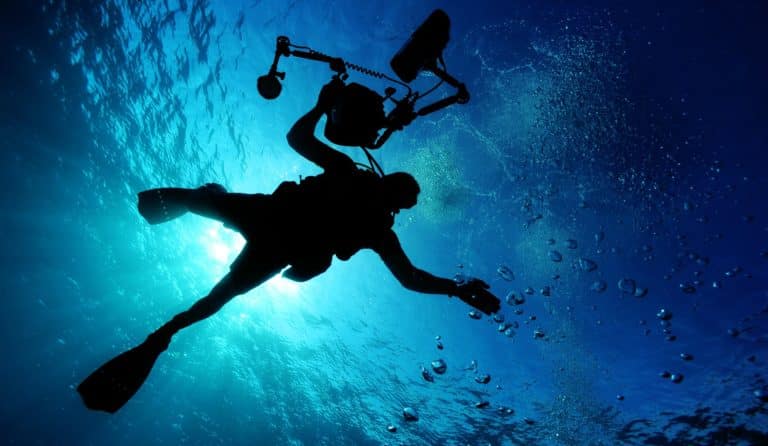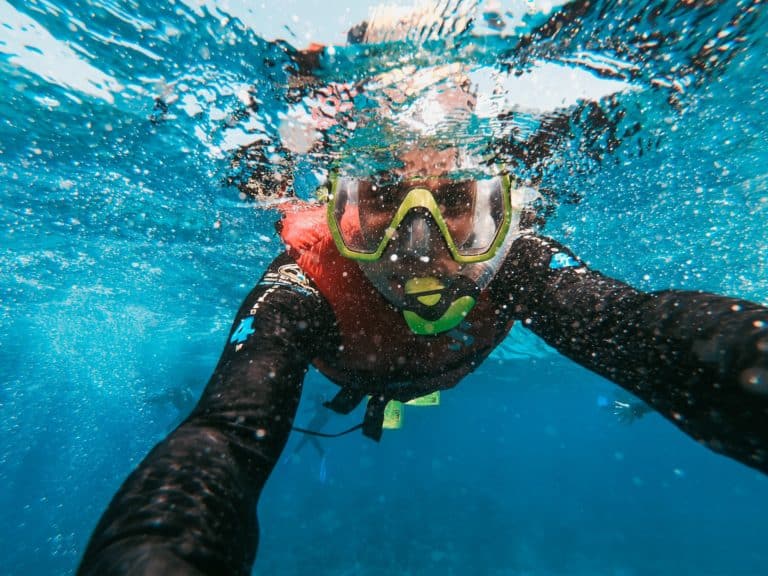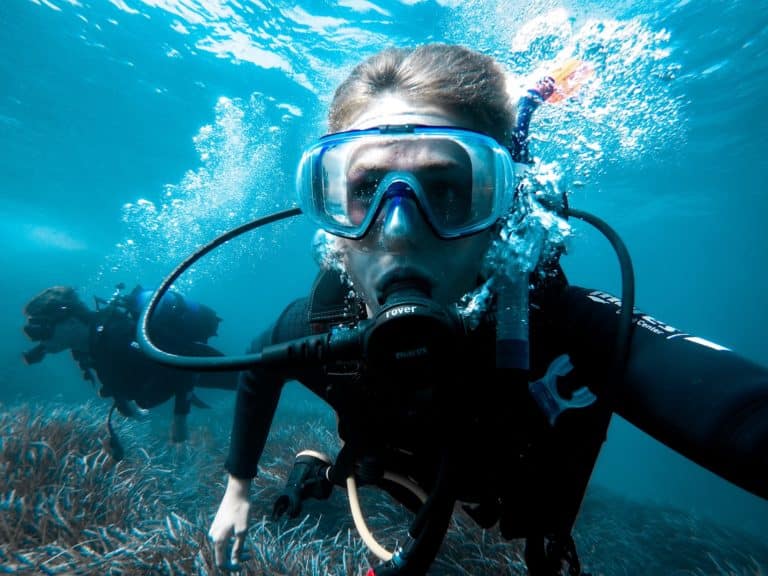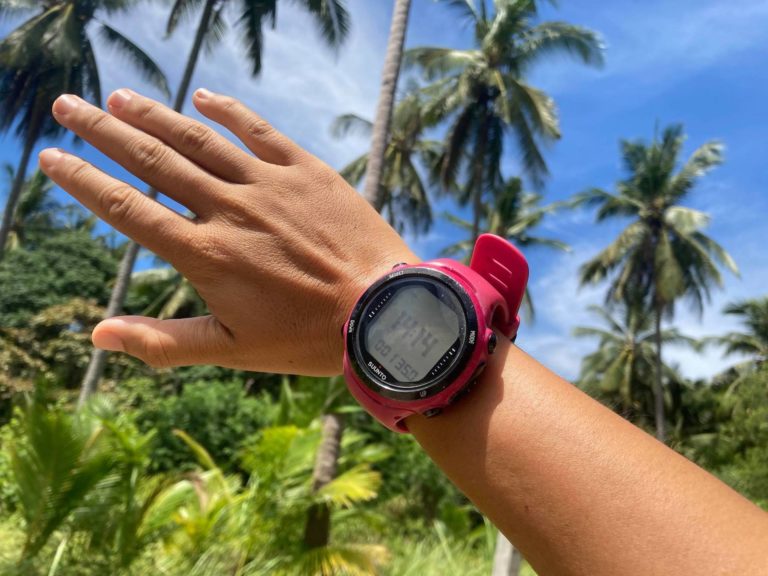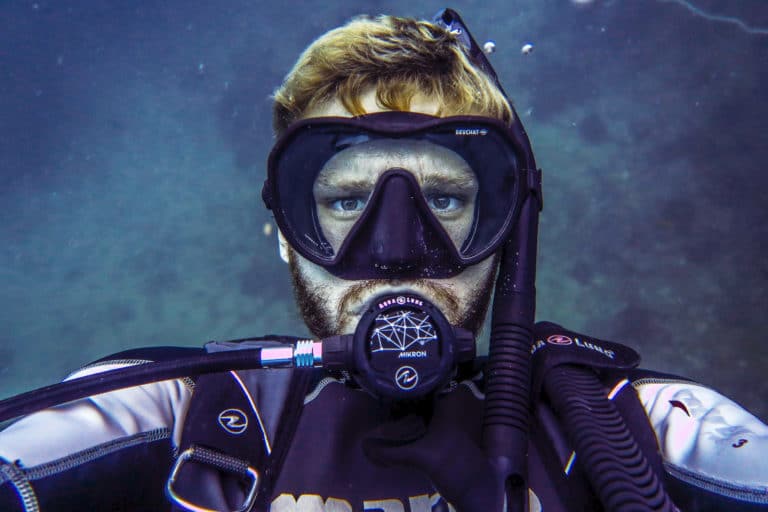Scuba diving is best done underwater. To get underwater, we need to go down. Humans are quite buoyant which means we naturally will float on the surface. So how do scuba divers go up and down? They use weights and a Buoyancy Control Device (BCD). Read on for more information on how do scuba divers go up and down, why buoyancy is so important, and what are the life-saving rules for divers when going for a dive!
How Do Scuba Divers Go Up and Down?
Scuba divers will use something called a Buoyancy Control Device (BCD). This is a bladder that can be inflated or deflated controlling the diver’s buoyancy.
The BCD can be a wrap-around jacket style, or as simple as a wing harness with just a bladder and straps. The BCD is connected to a hose called a Low Pressure Inflator (LPI) which is attached to the tank.
There are usually 2 buttons on the inflator hose, an inflate button and a deflate button. This controls how much air goes into your BCD, and how much air is released.
The amount of air in your BCD will determine whether you go up or down.

Learn about the top things scuba divers should do for their own safety.
What is Buoyancy?
If you’ve ever been diving, or researched diving, then you would have come across the term, ‘buoyancy.’ Buoyancy is the upward force that is the opposite to the weight of the object that is immersed in liquid. For example, if you put a ping-pong ball in a cup of water, the ball will float. This is positive buoyancy. Whereas if you put a lead ball in the cup, it will sink. This is negative buoyancy. And an object that does not float or sink, but remains in the middle, is neutrally buoyant!
What is Buoyancy Control?
In scuba diving, buoyancy is important as we want to control whether we are floating or sinking for safety. When we first enter the water, we want to float and be positively buoyant. This is so we can chat with our buddies, adjust our mask, check our dive computer is working, and make our way to our descent point.
However, when we are ready for our dive, we will need to be negatively buoyant and sink. This is when our lead weights will play an important role in helping us descend. You will want to do this slowly so that you have time to equalize your ears without hurting them, and so you don’t go crashing down into the coral below you.
When you are diving underwater, you will want to be neutrally buoyant. This is so you are not floating up to the surface, but also not sinking and dragging along the seabed.
POSITIVE BUOYANCY – How Do Scuba Divers Stay on the Surface?
To be positively buoyant or float on the surface, we would press the INFLATE button on your inflator hose. You can never overfill your BCD as there are valves that will release some air when the BCD is full. You can hear the ‘pff pff’ noise over your shoulder when it starts to release.
NEGATIVE BUOYANCY – How Do Scuba Divers Sink?
When you are ready to descend, this is when you would raise the inflator hose (because air travels up in water) and press the DEFLATE button on your inflator hose. As the air is dumped from your BCD, you will start to sink. This is mainly due to the weights that you are wearing, but also when you exhale and empty your lungs.
You should start off in a vertical position with your head on the top, legs below. This helps with equalizing your ears. After you are fully underwater you can switch into an upside-down position and have your legs above your head as you look down at the dive site and descend down.
Buoyancy Control Underwater
Before you go crashing into the sandy bottom, or worse, the coral reef, you will want to achieve neutral buoyancy. This is when you slow down your sinking by adding a tiny bit of air into your BCD. This is to counteract against the negative and sinking force. You do not want to add too much air, otherwise, you will just float back up to the surface! The best way to find that sweet, neutral buoyancy is to add a tiny bit of air, and then wait for a few seconds. This is because it will take a moment for the air to travel from your tank into your BCD bladder!
Buoyancy Control Diving
When you have achieved neutral buoyancy, you will be floating in mid-water. This is the fun part! Now you can use your lungs to go up and down. Breathing in and filling your lungs will cause you to float up a bit. While breathing out/exhaling and emptying your lungs will cause you to sink slightly. This is perfect when cruising over coral or a wreck at slightly different depths.
We love being neutrally buoyant as this means:
1. Conserving your energy, which in turn
2. Conserves the amount of oxygen your body needs,
3. Which means you use less air,
4. Which means a longer dive!
Negative Buoyancy Diving
If you find yourself too negatively buoyant and sinking, then you will waste a lot of energy trying to constantly swim away from the bottom of the floor. The more you kick or be active, the more energy you burn, which means the more oxygen you need, which means ultimately, a shorter dive. Booo.
Whereas if you are finding yourself too positively buoyant and floating up then you will waste a lot of energy trying to ‘swim down.’ This can cause stress and panic which might cause you to hold more air in your lungs, which makes you even more buoyant.
Now if you are using an aluminum tank, you will also need to think about your scuba tank’s buoyancy. A full aluminum tank is negative, whereas an empty tank will be positive. This means as you consume the air and use it, your tank will become positively buoyant. To counteract this, so you don’t float up to the surface halfway through your dive, you will need to release some air out of your BCD!
Why Can’t You Go Straight Up When Scuba Diving
Going up is a little more tricky. We never, ever want to go up fast as this can cause Decompression Sickness (DCS). This is when the absorbed nitrogen is released too quickly and the bubbles get stuck in your bloodstream causing this sickness or ‘The Bends.’
Read More: Why is Decompression Sickness Called ‘The Bends?’
So when a scuba diver goes up, they actually need to RELEASE some air out of the BCD and use their legs to kick and swim-up. Yes, I know it’s a little trickier to get this concept – many students question this a lot. But bare with me!
When you are neutrally buoyant, you will probably have a bit of air in your BCD. As you use the air from your aluminum tank, you will have the tendency to float up. As you end your dive, you will also be getting shallower. And as you get shallower, there is less pressure on your wetsuit or drysuit. The air in your BCD will also expand (remember how bubbles get larger close to the surface?).
So all of these things mean that you will be getting positively buoyant fairly quickly.
And if we allowed these factors to pull us up, without releasing air, then we will go up way too fast and, most likely, get that pesky little thing called DCS.
So when we decide to ASCEND, we want to begin to release some of the air in the BCD, so that the air cannot expand in our jacket or wing bladder. We want to put up our right hand above us to protect our heads, and we want to use our legs to slowly swim up to the surface. Ideally looking at the ‘ascent rate’ on our dive computer and keeping track of the speed.
When your right hand has broken the surface of the water, then you would use your left hand to press the inflate button to float again. Once you’ve established positive buoyancy, then you can remove your regulator, check and chat to your buddy, and start swimming back to the boat or shore!
Learn more about how to ascend and go up safely.
How Fast Can you Ascend in Scuba Diving?
PADI says to not go up faster than 18 meters per minute, SSI and many other agencies recommend 10 meters per minute. I go as slow as possible, checking my Suunto computer which is set to 9 meters per minute. If you find yourself going up to fast, then release more air out of your BCD and STOP KICKING. The number of times I’ve had students not realize that they were kicking out of habit!
So how do scuba divers go up and down? By using a combination of their BCD, weights, breathing, and their legs or hands to swim up. By establishing positive buoyancy on the surface and floating, scuba divers can be safe and ready for anything. By releasing the air in the BCD slowly means a scuba diver can be negatively buoyant and begin to sink and equalize. And by adding a tiny bit of air to an empty BCD means a diver can find their neutral buoyancy without kicking up or down too much. By conserving your energy and using minimal adjustments to your BCD and breathing means that you will conserve your air and be able to have a longer and more enjoyable dive!
